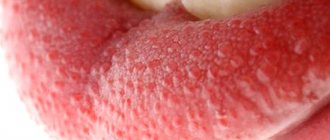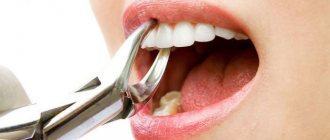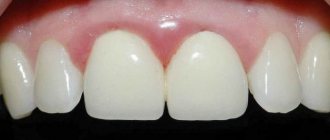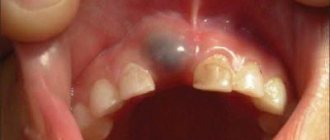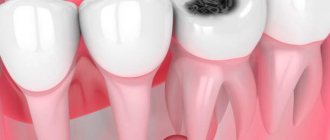From this article you will learn:
- what is periodontitis - symptoms, photos,
- anti-inflammatory therapy regimen,
- modern methods of treating periodontitis.
The article was written by a dentist with more than 19 years of experience.
Periodontitis is an inflammatory disease of the gums, which is accompanied by increasing destruction of the attachment of teeth to the bone tissue and soft tissues of the gums, which over time leads to tooth mobility. Periodontitis can appear in the area of only 1-2 teeth - in this case it is called localized, or it can be generalized (in the area of most teeth).
Most often, patients consult doctors with chronic generalized periodontitis, in which the gums of almost all teeth are inflamed. As a rule, most of these patients have a long history of self-medication of sore and bleeding gums (ie, symptoms of catarrhal gingivitis). Moreover, it is ineffective treatment or no treatment at all for gingivitis that leads to its gradual transformation into generalized periodontitis.
Periodontitis: generalized (Fig. 1) and localized (Fig. 2-3)
The causes of the localized form of periodontitis are local traumatic factors. This could be an overhanging edge of a filling or an artificial crown that injures the gums in the interdental space. The reason may also be “premature contacts” between the upper and lower teeth, which can appear either from natural causes or if the filling on the chewing surface or the crown is made a little higher than necessary.
Another common reason is when a dentist, when restoring a damaged tooth with a filling, incorrectly forms a contact point between the teeth in the interdental space. The lack of tight contact leads to constant food getting stuck in the interdental space and the development of inflammation. In the localized form (as opposed to the generalized form), symptoms of periodontitis occur only in teeth exposed to the traumatic factor.
What is periodontitis?
Periodontitis, or, as it is popularly called, dental periodontitis, is an inflammatory disease of the periodontal tissues that surround the tooth (gums, dental ligament and surrounding jaw bone). In professional terms, periodontitis is an inflammation of the ligaments of the tooth.
Periodontitis can be localized, that is, spread to the area of one or two teeth, or generalized, that is, affect most of the dentition. If a patient has periodontitis, it is usually chronic. Therefore, the main task of a specialist is to identify the cause of the disease, prescribe the correct treatment and, most importantly, prevent subsequent exacerbations and complications.
Stages of periodontal disease
Periodontal disease can be acute or chronic. Depending on the degree of spread of the pathology, there are the following types of disease:
- localized - the necks of the teeth are exposed in a separate area;
- generalized - pathological processes develop throughout the dentition.
Periodontal disease develops over several years; depending on the patient’s condition, the disease is divided into stages:
- Early - the presence of initial changes in tissues, which can be determined by the dentist during examination;
- The first is increased sensitivity of teeth to hot and cold foods, receding gums;
- The second is pronounced exposure of the dental necks, sensitivity, the formation of gaps between the teeth and the appearance of dental cement instead of enamel;
- The third is severe receding gums, gradual loosening of teeth;
- The fourth is the advanced stage: the teeth become very loose, making it difficult to eat. At this stage, tooth loss occurs.
What are the signs of periodontitis?
The initial signs of periodontitis are bleeding gums when pressing on them or when brushing teeth, bluish or red gums, and bad breath. Already in the later stages of the disease, tooth mobility and visible exposure of their roots appear, which indicates a severe and advanced form of the inflammatory process. When periodontitis becomes chronic, the tissues surrounding the tooth are “reabsorbed” and pathological gum and bone pockets are formed. As a result, the tooth gradually becomes loose and falls out.
It is necessary to distinguish the exposure of roots during periodontitis from the so-called gum recession - a decrease in the height of the gingival margin, as a result of which the root of the tooth is exposed, in other words, “sliding” or gum atrophy. Unlike periodontitis, recession is not caused by inflammation and does not entail the formation of pathological pockets and loosening of teeth. Additionally, in most cases, gum recession can be successfully treated.
Clinical researches
According to the results of the clinical use of the Asepta line of products: the examined patients, already at the first follow-up examination (after 1-2 days) of using the Asepta line of products, showed a decrease in complaints of discomfort in the gums. On examination, hyperemia and bleeding of the gingival papillae are noted. On the 7th day, complaints of gum bleeding persisted in a minority of patients.
Upon examination, a decrease in hyperemia and swelling of the gums was noted, but bleeding persisted upon probing. On day 14, 2 patients continued to complain of bleeding gums when brushing their teeth; upon examination, a significant decrease in hyperemia and swelling of the gums was noted. After the final application of the gel with propolis, normalization of clinical manifestations was revealed, which is manifested by the absence of bleeding during brushing and probing.
Improved dynamics of indicators allows us to recommend the Asepta line of products for the local treatment of inflammatory periodontal diseases.
Sources:
- Clinical experience in using the Asepta series of products Fuchs Elena Ivanovna Assistant of the Department of Therapeutic and Pediatric Dentistry State Budgetary Educational Institution of Higher Professional Education Ryazan State Medical University named after Academician I.P. Pavlova of the Ministry of Health and Social Development of the Russian Federation (GBOU VPO RyazSMU Ministry of Health and Social Development of Russia)
- The use of adhesive balm "Asepta®" in the treatment of inflammatory periodontal diseases L.Yu. OREKHOVA*, Dr. med. Sciences, Professor, Head of Department V.V. CHPP**, Dr. med. Sciences, Professor, Head of Department S.B. ULITOVSKY*, Dr. med. Sciences, Professor A.A. LEONTIEV*, dentist A.A. DOMORAD**, O.M. YAKOVLEV** SPbSMU named after. acad. I.P. Pavlova, St. Petersburg - *Department of Therapeutic Dentistry, **Department of Microbiology
- The use of new anti-inflammatory drugs in the complex of therapeutic and preventive measures for periodontal diseases (E.D. Kuchumova, A.A. Leontyev, O.V. Kalinina, L.Yu. Orekhova, S.B. Ulitovsky) E.D. Kuchumova, Ph.D., Associate Professor, A.A. Leontyev, dentist, O.V. Kalinina, dentist, L.Yu. Orekhova, Doctor of Medical Sciences, Professor, Head of Department, S.B. Ulitovsky, Doctor of Medical Sciences, Prof. Department of Therapeutic Dentistry of St. Petersburg State Medical University named after. acad. I.P. Pavlova
- Article “Treatment and hygiene features for mild and moderate periodontitis” by S.B. Ulitovsky head Department of PFS, Professor, Doctor of Medical Sciences, A.A. Leontyev Associate Professor of the Department of PFS, Ph.D. PSPbSMU named after. I.P. Pavlova
- Evaluation of the effectiveness of treatment of chronic generalized periodontitis of mild and moderate severity using Asepta antibacterial agents (S.I. Gazhva, A.I. Voronina) S.I. Gazhva, Doctor of Medical Sciences, Prof., Head of Department A.I. Voronina, aspirant, dentist, Department of Dentistry, Faculty of Dentistry, State Educational Institution of Higher Professional Education "Nizhny Novgorod State Medical Academy"
- Study of the clinical effectiveness of treatment and prophylactic agents of the Asepta line in the treatment of inflammatory periodontal diseases (A.I. Grudyanov, I.Yu. Aleksandrovskaya, V.Yu. Korzunina) A.I. GRUDYANOV, Doctor of Medical Sciences, Prof., Head of Department I.Yu. ALEXANDROVSKAYA, Ph.D. V.Yu. KORZUNINA, asp. Department of Periodontology, Central Research Institute of Dentistry and Maxillofacial Surgery, Rosmedtekhnologii, Moscow
What are the causes of periodontitis?
Understanding the causes of the disease is a very important point, which helps the doctor correctly determine how to treat gum periodontitis. The disease can be triggered by both general and local factors. Common causes include diseases of the gastrointestinal tract, diseases associated with pathology of the endocrine system, some gynecological and urological diseases, sexually transmitted infections, and a weakened immune system. Local, or local, factors are missing teeth, malocclusion, incorrectly installed fillings or crowns, which mechanically irritate the gums and create conditions for the accumulation of bacterial plaque. A significant role is played by the specific microbial flora of the oral cavity, which occurs in some patients and causes periodontitis. But the main factor in the development of periodontitis is poor oral hygiene.
How is periodontitis diagnosed?
It is possible to determine whether a patient has periodontitis or not already at the first appointment, focusing on his complaints and the condition of the oral cavity. Moreover, when diagnosing the disease, special tests are used, the most popular of which is the Parma index. It works as follows: a special Schiller solution is applied to the gums, which reacts to unhealthy tissues and colors them in a bright color, revealing the source of inflammation. There is also an index that determines the level of bleeding, and a Russell test that reveals the condition of not only the gums, but also the bone tissue.
X-ray studies, which determine the degree of the disease that has arisen, are the main ones in the diagnosis of periodontitis. For such a study, you can use a radiovisiograph (a device for conventional targeted X-rays), or an orthopantomograph (an extraoral device that can take a picture of both jaws at once). However, the most informative method is considered to be extraoral cone-beam computed tomography, which allows layer-by-layer examination of each piece of the jaw and tooth in three-dimensional format.
Currently, the Florida probe computer diagnostic technique has appeared, which allows you to most accurately determine and record the depth of periodontal pockets - the main pathological manifestation of periodontitis. The examination is easily tolerated by patients and helps the doctor prescribe appropriate treatment.
For periodontitis, a microbiological study is also carried out, with which you can study the microflora of the oral cavity and determine the sensitivity of microorganisms to antibiotics for a more accurate selection of drug treatment.
Another mandatory test is a blood test. It allows you to identify the cause of the disease, which may be either the initial stage of diabetes or a chronic infectious process in other organs and systems, as well as disorders associated with hormonal levels and metabolism.
In the process of diagnosing periodontitis, consultation with related specialists is often required to identify and treat concomitant diseases.
Removing tartar and plaque
This procedure is possible even at the initial appointment. The following methods are used:
- ultrasound;
- Air Flow technology – involves the use of abrasive particles, air and water;
- manual removal using a dental instrument;
- splitting the stone with acid;
- laser therapy.
Laser removal is one of the effective methods. With its help, you can not only clean teeth from tartar, but also destroy pathogenic microorganisms in the oral cavity.
How is periodontitis treated?
Successful treatment of periodontitis can only be achieved in a well-coordinated team of “doctor plus patient”. Much depends on the doctor, but even more depends on the patient himself. The doctor is responsible for the treatment, and the patient is responsible for maintaining the result, because periodontitis is a chronic disease.
Treatment methods for periodontitis are divided into medicinal and surgical. In case of minor inflammation caused by dental plaque, the doctor thoroughly cleans the teeth, eliminates conditions that contribute to the retention of microbial plaque, polishes the surfaces of the teeth and applies a therapeutic bandage with medication to the inflamed area. If a deep periodontal pocket forms and severe pain occurs, the patient may be prescribed antibiotics. When treating severe periodontitis, it is necessary to resort to more serious (surgical) procedures, such as curettage and flap operations. But in any case, periodontitis requires complex treatment, including professional hygiene, drugs for local and internal use, and, if necessary, surgical procedures.
There is also a hardware method for treating periodontitis - Vector. The method involves using ultrasound in combination with medications aimed at fighting microbes and stimulating healing. The Vector device is used both as an independent technique and in combination with surgical treatment.
What are the surgical treatments for periodontitis?
Surgical treatment of periodontitis is important in the later stages of the disease with severe tooth mobility and deep periodontal pockets. This is, first of all, a curettage procedure, which involves removing dental plaque and pathological granulation tissue from under the gums. If the depth of the periodontal pocket is up to 4 mm, closed curettage is performed without opening the gum; if it is more, open or flap surgery is performed, when it is necessary to detach the periosteal flap, fold it back and clean out the pocket. This procedure is always performed with pain relief and is well tolerated by patients.
In addition to the procedures described above, splinting is performed for periodontitis, which secures loose teeth.
Splinting procedure for periodontitis
The need for splinting in the treatment of periodontitis arises when there is mobility of more than 2-3 dental units in a row. Splinting helps strengthen teeth and also helps to quickly eliminate inflammatory processes in soft tissues.
Splinting can be carried out in different ways. A specialist can use fiberglass tapes in manipulations, install welded dental crowns or a clasp denture. The method of splinting is selected based on the clinical picture of a particular case.
Is it possible to eliminate periodontitis with a laser?
Laser treatment of periodontitis is one of the most effective and minimally invasive ways to combat the disease, which is one of the stages of complex treatment. The laser has cleansing and antibacterial properties. During the procedure, each periodontal pocket is treated for a certain time, sufficient for the laser light beam to destroy pathogenic bacteria. The procedure is bloodless and virtually painless. However, a good effect can only be obtained with an integrated approach to the treatment of periodontitis.
Results and discussion
The effectiveness of therapy is determined by the form and condition of the drug, methods of its use, which ensure the achievement of an optimal therapeutic effect. The physiological characteristics of the oral cavity include abundant salivation, which significantly reduces the concentration of the substance in the application area, reduces the exposure time of the medication and thereby reduces the therapeutic effect. In addition, the use of some products, due to the specific form and organoleptic characteristics, is not always positively perceived by the patient and poses a certain problem. Periodontal diseases are chronic in nature, and stopping the process or stabilizing it is possible only with an integrated approach to treatment using certain dosage forms, agents and therapeutic and preventive measures.
Modern means used for the treatment of periodontal diseases are represented by solutions, tinctures and extracts, gels, pastes, self-adhesive dressings, and absorbable treatment plates. Dosage forms have characteristic positive features and their own disadvantages, this creates the prerequisites for their further improvement.
Solutions and rinses
Solutions are used for irrigation of the oral mucosa, which is especially effective in the initial forms of marginal periodontitis (gingivitis), in preparation for the removal of subgingival dental plaque, and in the antiseptic treatment of periodontal pockets. Antiseptics are used in the form of solutions: iodine (Lugol's solution), 0.2–2.0% solution of chlorhexidine (for example, "BelSol" liquid concentrate No. 2, liquid for antiseptic treatment), 0.05% solution of Miramistin, 3% solution hydrogen peroxide. Aqueous solutions with antimicrobial and anti-inflammatory effects include: calendula tincture, propolis tincture, liquid extracts “Rotokan” and “Stomatofit”. For periodontal diseases, the “OKI” solution for topical use, containing ketoprofen lysine salt, is also recommended as an anti-inflammatory agent.
Instillation of the oral cavity with rinses has a beneficial effect on the surface of the mucous membrane, including in hard-to-reach places and interdental spaces. The therapeutic and prophylactic effect of liquid oral hygiene products, presented on the modern pharmaceutical and cosmetic market as elixirs, rinses, fresheners, balms, etc., is manifested in an antimicrobial effect.
When using solutions, the drug, as a rule, is washed away by the secretion of saliva and gingival fluid, this reduces its concentration at the site of inflammation and leads to entry into the gastrointestinal tract. Thus, studies have found that when using the Polikatan gel in combination with conventional therapy, the number of cases of normalization of microflora is 23–31% greater in comparison with the use of the aqueous form of the drug.
Prolonging the action of solutions is possible by introducing viscous polymers - for example, the Hyaludent solution with chlorhexidine (a solution based on chlorhexidine and sodium hyaluronate) for the antiseptic treatment of periodontal pockets. Hyaluronic acid creates a drug depot at the site of application and gradually releases chlorhexidine.
Gels and dressings
Dental gels for the treatment of periodontal pathology occupy a significant place. These are drugs such as “Metrogil Denta”, “Hyaludent with chlorhexidine”, “FtorAsept”, “Dicloran®Denta”, “Cholisal”, “Regenirin”, etc. The use of hydrophilic gelling agents (derivatives of cellulose, carbomer, gums of natural origin) in based on dental gels helps to enhance adhesiveness, focus the action of the active components of the drug with prolongation of the pharmacological effect. In addition, they have good thixotropic properties, fluidity and high permeability. The above dental gels are freely sold through pharmacy chains; their independent use for application is acceptable at home.
A promising basis for dental gels is the substance Tizol: it is convenient for application, does not damage the mucous membrane, is non-toxic, and has high adhesive ability. The drug "Tizol", used in the "linear" technique, is applied in a thin layer to the gingival surface - after 30-60 seconds the applied layer turns into a thin transparent film, which the patient practically does not feel.
Therapeutic periodontal dressings are used to prolong the effect of the drug in periodontal pockets. They have an anti-inflammatory effect, stimulate the regeneration of periodontal tissue after surgery and during therapeutic treatment. Periodontal therapeutic dressings mainly have an ointment base; the pharmacological prescription is represented by anti-inflammatory drugs, antibiotics, vitamins and immunostimulants.
The use of therapeutic dressings increases the exposure time of drugs on periodontal tissues to 2 hours or more. The disadvantages of their use are considered to be a violation of tissue trophism with the development of bedsores, the phenomenon of maceration, discomfort and unpleasant taste sensations, even nausea.
Pastes
In the complex of rehabilitation measures after deep curettage and operations on periodontal tissues, plastic self-hardening pastes are used. Therapeutic pastes “Septo-Pak” and “Parasept” are recommended for use to protect medicinal components placed in the gum pocket from being washed out by saliva. Such protective compresses are applied to periodontal tissues for 2–3 minutes, the final hardening of the paste occurs after 20–30 minutes.
Therapeutic and prophylactic dressing pastes “Vitadont” and “PPA1-RAD” stimulate reparative processes in periodontal tissues and promote the healing of traumatic and other damage to the oral mucosa. The exposure time of the dressing paste sometimes lasts several hours, and this does not allow it to be used as an isolating agent.
Anti-inflammatory drugs used in the treatment of periodontal pathology also include Solcoseryl dental adhesive paste and Asepta dental balm, prepared on the basis of pectin and cellulose derivatives. When applied locally to the gum mucosa, these drugs swell due to their base and are fixed, thereby prolonging the therapeutic effect to 15–30 minutes. The disadvantage of the form is the need to pre-dry the gums (when applied to an undried surface, the duration of action may be reduced) and the need to moisten the balm with water after application.
Films and plates
Dental films or self-absorbable sheets are also effective means of local antimicrobial and anti-inflammatory therapy. The basis of the self-absorbing plates “KP-Plast” “KP-Plast-phyto”, “KP-Plast-vita”, “KP-Plast-antimicrobial”, “Plates CM-1” is represented by natural polysaccharides. In addition, dental self-adhesive films “Diplen Denta” and collagen plates “Farmadont” are used.
They are applied directly to the affected area of the mucosa, the release of medicinal components is prolonged, for different compositions, lasts from 2 to 12 hours. The advantages of dental films are accuracy of dosage, constant concentration of biologically active substances during exposure time, strong fixation to wet and hard tissues, sufficient gas permeability for the normal course of reparative processes, ease of use, which makes it possible for patients to use them independently.
Good adhesion of films and plates is ensured by the polymer included in their composition (gelatin, collagen, polyvinyl alcohol). The plates, in contact with the wet gum, absorb saliva and gradually turn into a gel, fixing on the surface of the gum. A feature of Diplen-Dent films is the presence of two layers - hydrophilic and hydrophobic. The hydrophilic layer (hydrophilic side) has the ability to adhere to the moist mucous membrane. The outer hydrophobic layer is plastic, well modeled on the surface of the oral mucosa and isolates the affected area from external mechanical, chemical and bacterial influences.
Muds and mineral salts
Currently, the production of gingival applicators based on therapeutic mud (Saki silt sulfide and Tambukan) has been launched. They are highly hygienic, with good preservation of the active component, easy to use, which allows them to be used not only in dental offices of sanatoriums, but also at home. When irrigating the oral cavity with mineral water with brine, bischofite and other natural salts, elements of the keratinized epithelium are dissolved, the contents of pathological periodontal pockets are washed away, blood and lymph circulation of the tissues of the periodontal complex is improved and, as a result, an anti-inflammatory effect is manifested. A current trend is the development and production of dental gels and oral hygiene products based on natural mineral salts to expand the possibility of their use in the treatment of periodontal diseases.
Is it true that periodontitis can be cured with implantation?
Implantation is a method of combating not periodontitis itself, but its consequences. At a later stage of the disease, teeth become loose and fall out, so they have to be replaced with implants. It should be understood that dental implantation for periodontitis has its own difficulties and limitations, since bone tissue is absorbed in this disease. Its sufficient volume is the main condition for successful installation of implants. If periodontitis is in an advanced stage, implantation can be very difficult or even impossible due to a lack of bone volume. That is why patients should begin treatment as early as possible in order to do everything possible to preserve their teeth, and if they are lost, do not miss the opportunity to restore them with implants.
In any case, before installing implants, it is necessary to transfer periodontitis to the stage of remission (stabilization) or, if possible, eliminate the cause of its occurrence.
What consequences can untreated periodontitis lead to?
Loss of teeth
The advanced stage of the disease destroys the soft and hard tissues around the teeth, which leads to their loss.
Deterioration of conditions for implantation
As mentioned earlier, with severe periodontitis, the volume of the jaw bone is significantly reduced, which makes it difficult to install implants, requiring preliminary bone growth, and in extremely severe cases makes implantation impossible.
The occurrence of other diseases
Periodontitis contributes to diseases of the gastrointestinal tract, diseases of the lungs, heart and even the formation of blood clots.
How to avoid further exacerbation of the disease?
This is where the patient becomes the main member of a well-coordinated doctor-patient team. To maintain the results obtained after treatment of periodontitis, you should brush your teeth correctly and regularly, following all the recommendations of the treating dentist, since with periodontitis, individual oral hygiene differs from usual. In particular, along with a regular brush and paste, there is a need to connect additional hygiene products: dental floss, various brushes for teeth, an irrigator, etc.
In addition, it is necessary to come to the dentist for professional cleaning at least once every six months, and for people with chronic periodontitis even more often - once every three months. Good hygiene is an excellent prevention of periodontitis and the only way to maintain the results of treatment.
There is no inflammation with periodontal disease
When does the so-called periodontal disease, there is no inflammatory process in the gums. The clinical picture of “periodontal disease” differs sharply from periodontitis; it is with periodontitis of the tooth that inflammation occurs.
And injections into the gums, endless restorations of the necks of the gums - this is running in circles. Over time, again all the restoration fillings are chipped, and again these patients come to have these fillings restored again. And this happens endlessly
:
And the diagnosis of “periodontal disease” does not go away. As Desna ran away, she continues to leave. The fillings increase, that is, the teeth increase in size, because the gums sag more and more, and nothing useful happens.
When such a patient gets an appointment with me, unwinding his entire tangle of ordeals during the consultation, it becomes clear that all previously performed gum treatment consists of 3
factors:
- Lost time,
- lost money
- shattered hopes.
The diagnosis was incorrect and the treatment was appropriate for the incorrect diagnosis. What went wrong?
Patients should always go for a consultation with such a diagnosis... to an orthodontist
.
Because periodontal disease is an occlusal injury
.
What I see in these patients with signs of periodontal disease is a completely different diagnosis. This is an occlusal injury that can only be corrected by an orthodontist.
How much does it cost to cure periodontitis? What does the cost consist of?
The price for periodontitis treatment depends on the complexity of the disease, whether surgical procedures will be performed and to what extent.
Important!
Folk remedies in the form of all kinds of herbal infusions do not help with periodontitis. They can bring temporary relief and mask the problem, but mouth rinses cannot radically solve it. Neither home treatment nor the miraculous toothpaste from TV commercials will help get rid of periodontitis. Rinses and toothpastes are just one of the auxiliary components in complex treatment. If you have periodontitis or suspect it, contact the dentist for timely diagnosis, since it is in the early stages of the disease that doctors have a lot of opportunities to help you!


